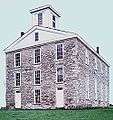Eleutherian College
|
Eleutherian College Classroom and Chapel Building | |
|
Eleutherian College and Chapel Building | |
  | |
| Location | Lancaster, Indiana |
|---|---|
| Coordinates | 38°49′51″N 85°30′59″W / 38.83083°N 85.51639°WCoordinates: 38°49′51″N 85°30′59″W / 38.83083°N 85.51639°W |
| Architect | Unknown |
| Architectural style | Greek Revival |
| NRHP Reference # | 93001410[1] |
| Significant dates | |
| Added to NRHP | December 15, 1993 |
| Designated NHL | February 18, 1997[2] |
Eleutherian College, founded in 1848 as Eleutherian Institute, was the first college in the U.S. state of Indiana to admit students without regard to race or sex.[3] Its surviving main building is now a public museum and has been declared a National Historic Landmark.
Its name comes from the Greek word eleutheros which means "free". It is located in the unincorporated community of Lancaster in Jefferson County.
History
The college was founded by members of the Neil's Creek Abolitionist Baptist Church, with much of the organizing done by the extended Hoyt-Whipple family. Lyman Hoyt was married to Asenath Whipple Hoyt, the niece of William Whipple, one of the signers of the Declaration of Independence. Asenath’s sister, Lucy Whipple Nelson, was a strong abolitionist and encouraged Lyman and Asenath to move to Lancaster, Indiana. Walter Hoyt, Lyman's brother, and their brother Benajah soon followed. In the 1830s-1860s, Lancaster was the center of a burgeoning abolitionist community, largely centered on the Neil's Creek Abolitionist Baptist Church. The Hoyts soon became involved in the Neil's Creek Church. Lyman Hoyt became a well-known "conductor" on the Underground Railroad, and provided shelter and supplies to runaway slaves. The Hoyts helped to establish the Eleutherian College in 1848, following the advice of Thomas Craven of Oxford, Ohio, an early advocate of an integrated educational system. In 1856 the college built a stone school house which still stands on a hill in Lancaster.[4]
Some of the Eleutherian College's trustees were active in the Underground Railroad and made Lancaster an important stop for fugitive slaves traveling from Madison on the Ohio River to Indianapolis. In 1856, the college had 18 African-American students, 10 of whom were born slaves. In 1860, two hundred students were enrolled, 50 of them African-American. This was at a time when the Indiana Constitution prohibited African-American immigration into the state.
The college and chapel building, constructed between 1854 and 1856, became a public school in 1888 and remained in use until 1938.
Gallery
 Old NPS picture of the school
Old NPS picture of the school- Distant view
References
- ↑ National Park Service (2007-01-23). "National Register Information System". National Register of Historic Places. National Park Service.
- ↑ "Eleutherian College Classroom and Chapel Building". National Historic Landmark summary listing. National Park Service. Retrieved 2008-07-23.
- ↑ Bennett, Jeffrey D. (May 21, 1996). "National Historic Landmark Nomination: Eleutherian College Classroom and Chapel Building" (PDF). National Park Service. and Accompanying twelve photos from 1996
- ↑ W. Thompson, History of Eleutherian College (Lancaster, Indiana, 1923)
External links
| Wikimedia Commons has media related to Eleutherian College. |
- Historic Eleutherian College
- Eleutherian College Historical Marker
- National Park Service: Aboard the Underground Railroad


